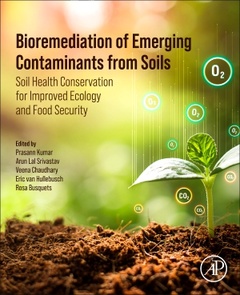Bioremediation of Emerging Contaminants from Soils Soil Health Conservation for Improved Ecology and Food Security
Coordonnateurs : Kumar Prasann, Chaudhary Veena, van Hullebusch Eric D., Busquets Rosa, Srivastav Arun Lal

Bioremediation of Emerging Contaminants from Soils: Soil Health Conservation for Improved Ecology and Food Security deals with current challenges of sustainable soil health using eco-friendly approaches. This book provides ways of reducing the chemicals burden on the soil by maintaining balance in terms of society, environment and economy, which are considered basic pillars of sustainability. Presented in two parts, the book first highlights emerging contaminants and their sources. The second part explores a variety of steps and tools for addressing contaminated soils including bio- and phytoremediation options. Case studies in each part provide real-world insights for practical application. This book will be unique in the specified area of sustainability using the principles of bioremediation. Moreover, scientists, researchers, and policymakers will receive insights to develop and explore innovate approaches to achieve sustainable development goals.
Section 1: Emerging soil contaminants 1. Exponential population growth and global food security: Challenges and alternatives 2. Agricultural soil contaminations due to industrial discharges: challenges for public health protection and food security 3. Traditional approaches of agriculture soil remediation: boon or bane for global food security 4. Polycyclic aromatic hydrocarbons bioremediation mechanisms by non-ligninolytic fungi: a multiscale approach 5. Phenolic compounds: a big threat to the agricultural soils 6. Pharmaceutical compounds: a recent threat to the agricultural soils (sources, transport and negative impacts on the crop’s quality and other adjacent ecosystems) 7. Sources of inorganic non-metallic contaminants (synthetic fertilizers, pesticides) in agricultural soil and their impacts on the adjacent ecosystems 8. Sources of inorganic metallic contaminants (lead, cadmium, arsenic, etc) in agricultural soil and their impacts on the adjacent ecosystems 9. Environmental threats posed by xenobiotics in the modern day 10. Bioremediation of xenobiotics contamination in soil 11. Transgenic plants for xenobiotic remediation 12. Xenobiotic stress management by microbial endophytes 13. Case studies on emerging contamination of soil Section 2: Management options for emerging soil contaminates: 14. Bioremediation of metal contaminated soil: Comparison of microbial agents with the plants 15. Phytoremediation of metal contaminated soil using energy crops: Soil health maintenance along with biofuel production 16. Phytoremediation of phenolic compounds from the soil 17. Phytoremediation of pharmaceutical compounds from the soil 18. Alternative natural options of synthesized agrochemicals in agriculture 19. Role of enzymes in the optimization of traditional phytoremediation process of soil 20. Optimized phytoremediation process for the sustainable management radionuclides 21. Role of indigenous knowledge in the agricultural soil reclamation without disturbing other ecosystems 22. Role of hyperaccumulators in the reduction of emerging industrial pollutants from soil 23. Microbes assisted Bioaugmentation process in the reduction of emerging industrial pollutants from soil 24. Application of genetically modified crops against metallic contaminations 25. Crop rotation patterns and soil health management 26. Application of microphytes for soil reclamation 27. Utilization of genetically modified weed plants against industrial contaminants: A promising tool of phytoremediation 28. Case studies on management practices for emerging contamination of soil, challenges and future scope
Prof. Veena Chaudhary is working as an Associate Professor in the Department of Chemistry at Meerut College, Meerut, affiliated with CCS University, Meerut. Dr. Chaudhary is deeply attached to chemistry, with a specialization in Environmental Chemistry. She has to her credit more than 50 research papers, two book chapters and 20 abstracts. She received numerous awards, including a Young Scientist Award, a Fellow Scientist Award, and numerous others, for her contributions to the environmental field for the advancement of the social, welfare, and agricultural sectors. She is a life member of several scientific societies. She also visited abroad several times to attend international conferences and seminars for the purpose of gathering and sharing scientific knowledge. She is handling several research projects funded by DST, UP-CST, and higher education in Uttar Pradesh.
Eric D. van Hullebusch is a Professor in Biogeochemistry of Engineered Ecosystems at the Institut de Physique du Globe de Paris. He holds a Ph.D. from the Universite de Limoges. His research activities are mainly focused on the study of metals and metalloids biogeochemistry in engineered ecosystems (e.g. bioreactors) mainly dedicated to wastewater treatment for pollution control and resource
- Contains the latest practical and theoretical aspects of the soil health crisis and its management
- Presents collective information to ensure the remediation of soil from emerging contaminants
- Serves as baseline information for environmental issues in agriculture, along with their alternative eco-friendly solutions
Date de parution : 05-2024
Ouvrage de 724 p.
19x23.3 cm



